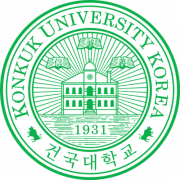
Konkuk University
Green Education Ranking
#611
About Konkuk University
Konkuk University, a private institution located in South Korea, boasts its main campus in Seoul, the capital city, and a secondary campus in Chungju, nestled in the picturesque North Chungcheong province. Established in 1946 as the Chosun School of Politics, with a vision to cultivate future political leaders, the university was founded by Dr. Yoo Seok-chang, a visionary medical doctor who transitioned from operating a People’s Hospital in 1931 to focusing on the education of young leaders. Renamed Konkuk University in 1959, the term "Konkuk" symbolizes "founding a nation." Recognized as a national leader in agricultural and life science research, Konkuk has earned the reputation of being the "fastest-growing university in Korea." Apart from Korean language instruction, the university offers a diverse range of courses taught in languages such as English, Japanese, Spanish, Vietnamese, French, and Chinese through the Konkuk University Language Institute, established in 1990. This institute provides international students with an immersive experience to study while immersing themselves in Korean culture. Additionally, it offers Korean language classes to individuals from around the world. Konkuk's Seoul campus features prominent landmarks including the Sanghuh Memorial Library, inaugurated in 1989 and once the largest library in Asia; the Konkuk University Museum, showcasing approximately 4,500 historical artifacts; and the scenic Ilgam Lake, a focal point of the campus, previously utilized for winter ice-skating competitions. Among its alumni are notable figures such as the poet Kim Hyesoon, actor Uhm Tae-woong, and Choi Na-yeon, the winner of the 2012 US Women’s Open Golf Championship.
About World Green University Ranking
World
Green University Ranking 2024 is a
scholarly acknowledgment of educational
institutions standing at the forefront of
Education for Sustainable Development (ESD) and
leading the Green Education Transformation
(Education 6.0).
World Green University Ranking classifies
universities based on the six pillars of the
Holistic Green Education Framework, including
leadership governance, curriculum, innovation,
facilities, human capital, and community
partnerships.
The methodology employed in our Green Education Ranking is designed relying on the six pillars of the Holistic Green Education Framework. Each pillar contributes to the institution’s overall score, with a carefully assigned weight reflecting its significance in fostering sustainability. The total weight of the six pillars collectively amounts to 100%, signifying a balanced evaluation across critical dimensions of Green Education. Within each pillar, various standards are carefully assessed, with weights ranging between 1 and 2, emphasizing the varying importance of each criterion. This nuanced approach ensures a holistic evaluation and offers an insightful measure of universities commitment to Green Education Transformation (Education 6.0).
| # | Six Pillars of Green Education Framework (6Gs). | Weight |
|---|---|---|
| 1 | Green Educational Leadership | 14% |
| 2 | Green Curriculum | 17% |
| 3 | Green Innovation and Research | 19% |
| 4 | Green Facilities | 15% |
| 5 | Green Human Capital | 19% |
| 6 | Green Communities | 16% |
| Total | 100% |

